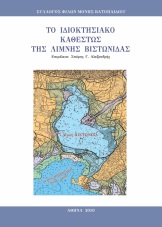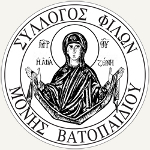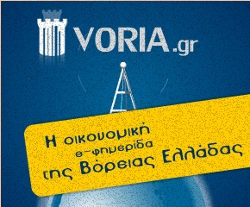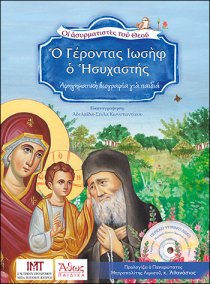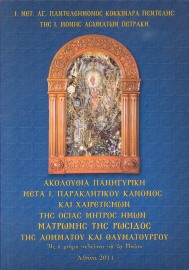The schedule of visits of the Holy Belt of Theotokos in Russia
21 Οκτωβρίου, 2011 — ZpapSermon on the Nativity of the Virgin Mary
7 Σεπτεμβρίου, 2011 — vatopaidifriend3Saint Andrew, Archbishop of Crete
The present Feast is for us the beginning of feasts. Serving as boundary to the law and to prototypes, at the same time it serves as a doorway to grace and truth. “For Christ is the end of the law” (Rom 10:4), Who, having freed us from the letter (of the law), raises us to spirit.
Here is the end (to the law): in that the Lawgiver, having made everything, has changed the letter in spirit and gathers everything in Himself (Eph 1:10), enlivening the law with grace: grace has taken the law under its dominion, and the law has become subjected to grace, so that the properties of the law not suffer reciprocal commingling, but only so that by Divine power, the servile and subservient (in the law) are transformed into the light and free (in grace), so that we are not “in bondage to the elements of the world” (Gal 4:3) and not in a condition under the slavish yoke of the letter of the law.
The Tenderness of the Mother of God Versus Rudeness, the Rule of Contemporary Pseudo-culture
28 Αυγούστου, 2011 — vatopaidifriend3In the Name of the Father and of the Son and of the Holy Spirit.
Today is one of the most important of the Twelve Great Feasts. We glorify the Dormition of the Most Holy Mother of God.
There was no human honour or glory in the life of the Queen of Heaven. And the only event linked with Her earthly life, surrounded by honour and glory, is Her falling asleep. We know about the Dormition of the Most Holy Mother of God from the Tradition of the Church, from reliable testimonies of the ancient Church Fathers, starting with St Dionysius the Areopagite and Melito of Sardis as well as St Epiphanius of Cyprus, St Ambrose of Milan and St Juvenal, Patriarch of Jerusalem. The first five centuries of Christian history already commemorate in a great many detailed accounts the earthly life of the Most Holy Mother of God and Her Dormition.
The Dormition: Icon of Hope
16 Αυγούστου, 2011 — vatopaidifriend3 On August 15, the Dormition of the Mother of God is celebrated by most Christians in the world. The Church year begins on September 1, and the first Great Feast of the year is the Nativity of the Theotokos, making the Dormition of the Theotokos the last great feast of the year. It is entirely fitting that these two feasts – celebrating the birth and falling-asleep of Mary respectively – should buttress the entire church calendar. The Church calendar tells us the story of our Salvation in the traditional way, with the climax of the story coming in the middle, which is when Easter is celebrated, before ending in a way which is somewhat symmetrical and complimentary to the beginning. Therefore, the final “scene” in our story of Salvation is the Dormition of Mary, the Mother of God.
On August 15, the Dormition of the Mother of God is celebrated by most Christians in the world. The Church year begins on September 1, and the first Great Feast of the year is the Nativity of the Theotokos, making the Dormition of the Theotokos the last great feast of the year. It is entirely fitting that these two feasts – celebrating the birth and falling-asleep of Mary respectively – should buttress the entire church calendar. The Church calendar tells us the story of our Salvation in the traditional way, with the climax of the story coming in the middle, which is when Easter is celebrated, before ending in a way which is somewhat symmetrical and complimentary to the beginning. Therefore, the final “scene” in our story of Salvation is the Dormition of Mary, the Mother of God.
The Icon of the feast depicts various strands of the story in one single frame. The story is this:
The Dormition of Theotokos (2)
15 Αυγούστου, 2011 — vatopaidifriend3
Sermon (2) by St. John of Damascus
THERE is no one in existence who is able to praise worthily the holy death of God’s Mother, even if he should have a thousand tongues and a thousand mouths. Not if all the most eloquent tongues could be united would their praises be sufficient. She is greater than all praise. Since, however, God is pleased with the efforts of a loving zeal, and the Mother of God with what concerns the service of her Son, suffer me now to revert again to her praises. This is in obedience to your orders, most excellent pastors, so dear to God, and we call upon the Word made flesh of her to come to our assistance. He gives speech to every mouth which is opened for Him. He is her sole pleasure and adornment. We know that in celebrating her praises we pay off our debt, [172] and that in so doing we are again debtors, so that the debt is ever beginning afresh.
The Dormition of Theotokos (1)
15 Αυγούστου, 2011 — vatopaidifriend3
Sermon by St. John of Damascus
THE memory of the just takes place with rejoicing, said Solomon, the wisest of men; for precious in God’s sight is the death of His saints, according to the royal* David. If, then, the memory of all the just is a subject of rejoicing, who will not offer praise to justice in its source, and holiness in its treasure-house? It is not mere praise; it is praising with the intention of gaining eternal glory. God’s dwelling-place does not need our praise, that city of God, concerning which great things were spoken, as holy.† David addresses it in these words: «Glorious things are said of thee, thou city of God.» What sort of city shall we choose for the invisible and uncircumscribed God, who holds all things in His hand, if not [148] that city which alone is above nature, giving shelter without circumscription* to the supersubstantial Word of God? Glorious things have been spoken of that city by God himself. For what is more exalted than being made the recipient of God’s counsel, which is from all eternity?
A Homily on the Dormition of Our Supremely Pure Lady Theotokos and Ever-Virgin Mary
14 Αυγούστου, 2011 — vatopaidifriend3![]()
by St. Gregory Palamas
Both love and duty today fashion my homily for your charity. It is not only that I wish, because of my love for you, and because I am obliged by the sacred canons, to bring to your God-loving ears a saving word and thus to nourish your souls, but if there be any among those things that bind by obligation and love and can be narrated with praise for the Church, it is the great deed of the Ever-Virgin Mother of God. The desire is double, not single, since it induces me, entreats and persuades me, whereas the inexorable duty constrains me, though speech cannot attain to what surpasses it, just as the eye is unable to look fixedly upon the sun. One cannot utter things which surpass speech, yet it is within our power by the love for mankind of those hymned, to compose a song of praise and all at once both to leave untouched intangible things, to satisfy the debt with words and to offer up the first fruits of our love for the Mother of God in hymns composed according to our abilities.
The Solemnity of the Assumption of Mary
14 Αυγούστου, 2011 — vatopaidifriend3
The Assumption of Theotokos by Murillo
Although probably not unknown in the early Church, the earliest references to the Assumption of the Virgin Mary appear in the 4th (or possibly late 3rd) century in Liber Requiei Mariae(The Book of Mary’s Repose), and in the writings of a Bishop Meliton. […] St. John of Damascus (d. AD 755) relates a tradition where, during the Council of Chalcedon (AD 451), the emperor Marcian and his wife wished to find the body of Mary. He tells how all the apostles had seen her death, but her tomb was empty upon inspection.
The Dormition
14 Αυγούστου, 2011 — vatopaidifriend3Who is she who rises resplendent, all pure, and bright as the sun?
There is no mention of the Dormition or Assumption in the New Testament, only in apocryphal sources, but it is one of the earliest feast observed in the church. The feast of the Dormition dates at least from the 5th C. It was always celebrated in Jerusalem on this date, whilst in some other parts of the Eastern church the date varied. In the 7th C, the Byzantine emperor, Maurice decreed that the Dormition be celebrated everywhere on the 15th. Later the Western Church adopted the same date, but always kept it simply as the Assumption.
Spiritual Benefits of the Dormition
13 Αυγούστου, 2011 — vatopaidifriend3Why is it really necessary for Christians to pay attention to the death of Mary the Mother of Jesus? Does it add anything to our spirituality, does it increase our moral sensibilities, does it fill our minds with wisdom? These are interesting questions. I can remember as a Protestant Christian that I would have certainly answered any questions like this in the negative, and I can remember teaching people to believe that the life and contribution of Mary really had nothing to do with their day to day Christian walk. But I’ve certainly changed my mind on this issue. in this episode of Harmony of Thunder we’re going to look again at the sermon of Patriarch Modestus on the Dormition of the Theotokos in order to try and uncover the answer to the question: in what way does our attention to this great feast of the Orthodox Church benefit us as Christians?
Why a Fast for Dormition?
9 Αυγούστου, 2011 — vatopaidifriend3by Daniel Manzuk
It would be a gross understatement to say that much has been written about the Feast of the Dormition of the Theotokos. Yet very little has been written about the fast that precedes it.
Every Orthodox Christian is aware and generally knows the reason behind the fasts for Pascha and Christmas. But while they may know of the Dormition Fast, few follow it, and more than a few question why it is there, neither knowing its purpose. First, given the pervasive misunderstanding of the purpose of fasting itself, a refresher on its purpose is always a good idea.
«I went to Christouli and Panagitsa high in heaven»
5 Αυγούστου, 2011 — vatopaidifriend3I went to Christouli (Christ Jesus) and Panagitsa (Mary, Most Holy Mother of God) high in heaven» (amateur translation)
E. and T. T., from Drosato N. Kilkis, are the parents of three children. They relate the following: «On March 30th 2001 we took our M., four and a half years old, to the Hospital in Thessaloniki because of an unbearable stomach pain. With the appropriate tests they diagnosed him with obstructive ileus, and operated on him for three and a half hours, removing half a meter of necrotic gut.
Bright Friday
29 Απριλίου, 2011 — vatopaidifriend3
On Bright Friday, in addition to the normal Paskhal hymns and the hymns from the Octoechos, special stichera and a canon in honor of the Theotokos (Mother of God or Birthgiver of God) are chanted in commemoration of her Icon of the «Life-giving Spring.»
The Life-giving Spring or Life-giving Font is both the feast day of a historic church in Constantinople and an icon of the Theotokos (Virgin Mary) which is venerated by the Eastern Churches.
Living water (1): A well springing up into everlasting life
13 Απριλίου, 2011 — vatopaidifriend3
Icon of Christ the Life-giving fount
O MOTHER of God, as living and ungrudging source, establish those united in spiritual fellowship who sing you hymns of praise, and in your divine glory grant them crowns of glory.
**
I’ve been exploring the fascinating Biblical allusions to be found in the Canon of the Akathist. The next line I thought I’d look at reads:
HAIL, Sovereign Lady, never failing spring of the living Water.
Τhe Annunciation of the Most Holy Theotokos
26 Μαρτίου, 2011 — vatopaidifriend3
We shall continue with our lessons on the theology of icons, with the depiction of the Annunciation of the Theotokos. The event of the Annunciation is described in Luke’s Gospel, in which the Evangelist describes numerous events that are linked to the Theotokos, and especially to the birth of Christ. The birth of Christ is also described by Matthew the Evangelist, but the details that pertain to these events are described by Luke, who had met the Theotokos in person and had learnt of those events – for example of the Annunciation – directly from the Holy Mother.
Miracles by the Holy Belt of Most Holy Theotokos (Virgin Mary) [Volume 15]
28 Οκτωβρίου, 2010 — vatopaidifriend3The Protection of the Most Holy Theotokos
28 Οκτωβρίου, 2010 — vatopaidifriend3This feast of the Protection of the Theotokos is neither one of the Twelve Great Feasts of the Church nor is it a commemoration of any events in the earthly lives of our Lord or His Mother. So why does the Orthodox Church here in twenty-first-century North America keep this feast?
Miracles by the Holy Belt of Most Holy Theotokos (Virgin Mary) [Volume 14]
27 Οκτωβρίου, 2010 — vatopaidifriend3Miracles by the Holy Belt of Most Holy Theotokos (Virgin Mary) [Volume 13]
26 Οκτωβρίου, 2010 — vatopaidifriend3Miracles by the Holy Belt of Most Holy Theotokos (Virgin Mary) [Volume 12]
25 Οκτωβρίου, 2010 — vatopaidifriend3Miracles by the Holy Belt of Most Holy Theotokos (Virgin Mary) [Volume 11]
23 Οκτωβρίου, 2010 — vatopaidifriend3La Fête de la Nativité de la Théotokos
8 Σεπτεμβρίου, 2010 — vatopaidifriend3La Fête de la Nativité de la Théotokos est une occasion pour rechercher les bénédictions présentes dans cette Acathiste, de déterrer les trésors qui y ont été enfouis par ses auteurs. Nous pouvons tirer un parallèle et montrer la source de nombre de ses images avec la Sainte Écriture. Et une de ces sources est justement l’épître prévue pour la Fête. Saint Paul, s’adressant à l’église à Philippes, parle des 3 attributs du Christ notre Dieu : 1) Il est venu nous servir; 2) Il l’a fait dans l’obéissance à la volonté de Dieu; et 3) Il a été exalté aux Cieux. Bien que les paroles de l’Apôtre s’appliquent au Seigneur Jésus, les attributs peuvent aussi être appliqués à la Mère de Dieu. Vous les retrouverez en abondance tout au long de l’Acathiste, avec un portrait de Marie se donnant elle-même, dans l’obéissance et le service. Ce qui est à remarquer dans l’hymne, c’est l’appel de Dieu qui nous est adressé : afin que nous fassions de ces vertus quelque chose de fondamental dans nos vies. encore…
